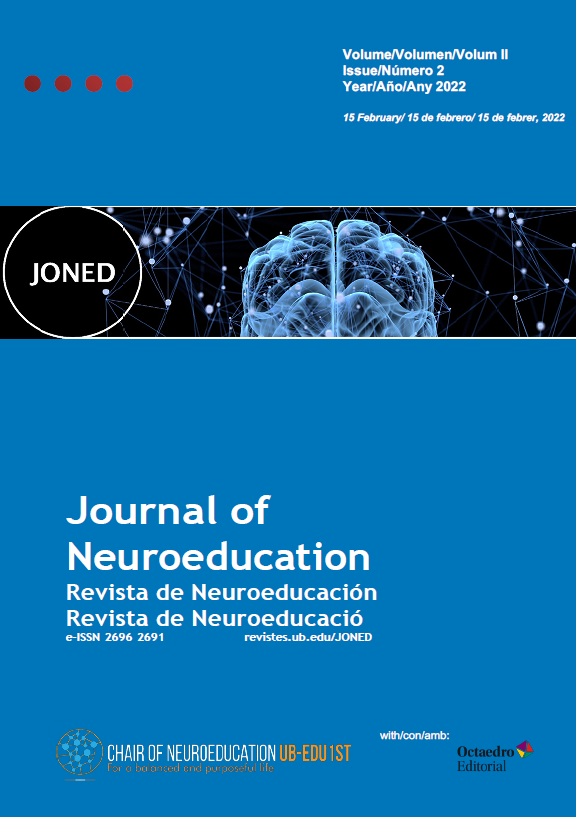Proyecto d'especificitat curricular per trastorns en l'espectre autista: una experiència a Llatinoamèrica
Currículum escolar en l'autisme
DOI:
https://doi.org/10.1344/joned.v2i2.37435Paraules clau:
autisme, educació, especificitat, currículum, capacitació, docentResum
Els nens amb trastorns a l'espectre autista (TEA) necessiten un ensenyament explícit, declaratiu, per les seves maneres diferents de processar la informació. L'objectiu del projecte va ser desenvolupar un programa educatiu individualitzat per a alumnes amb autisme, capacitar per a l'especialització teoricopràctica els docents involucrats en equips de tota una província i establir un sistema d'avaluació de continguts tant per als alumnes com per a l'especificitat a la formació docent. MÈTODES: Es va establir una comissió curricular per al desenvolupament del programa d'ensenyament, un curs teòric setmanal i una supervisió en servei pràctica, de freqüència mensual dels equips docents de tota la província. Es va completar amb un disseny de butlletí de qualificacions per als alumnes, dels continguts del currículum específic. Pels docents i equips tècnics, es va valorar amb un examen final i enquestes, sobre els aprenentatges rebuts. RESULTATS: Va ser possible aplicar l‟especificitat curricular en el procés d‟inclusió educativa en els alumnes al llarg d‟un any. Els docents van aprovar totalment el curs de capacitació i es van obtenir les enquestes de satisfacció favorables als aprenentatges incorporats en relació a l'especialització curricular. Fou possible el canvi conceptual en els professionals, en relació amb l'especificitat de l'aprenentatge dels alumnes amb TEA.
Descàrregues
Referències
Simmons, E. S., Lanter, E., & Lyons, M. C. Supporting mainstream educational success. Handbook of Autism and Pervasive Developmental Disorders, 4 Edicion.2014.
Valdez, D. Educación inclusiva. En: J. Seda (comp.) Convención sobre los derechos de las personas con discapacidad. Avances, perspectivas y desafíos en la sociedad argentina. Buenos Aires: Eudeba2017
Dunst, C. J. Family centered practices: Birth through high school. Journal of Special Education 2002; 36(3), 139-147.
Baron Cohen, S. Autismo y Síndrome de Asperger, Madrid, Alianza 2012.
CIE-11 Clasificación Internacional de Enfermedades, 11 Ediciòn Versión online. https://icd.who.int/es 2021.
Rivière Á, Martos J.El tratamiento del autismo: nuevas perspectivas. Ministerio de trabajo y Asuntos Sociales, Madrid. 1997.
Fejerman, N., &Grañana, N. Neuropsicología infantil. Paidos.Buenos Aires. 2017.
Valdez, D., Martos, J., Llorente, M., &Solcoff, K. Autism in the first person. The challenges of Ángel Rivière (Autismo en primera persona. Los desafíos de Ángel Rivière). Journal for the Study of Education and Development 2020; 43(4), 808-823.
Morales Hidalgo, P., Voltas Moreso, N., & Canals Sans, J. Autism spectrum disorder prevalence and associated sociodemographic factors in the school population: EPINED study. Autism, 2021;25(7), 1999-2011.
Cuartero, S. D. Tecnologías para la enseñanza y el aprendizaje del alumnado con Trastorno del Espectro Autista: una revisión sistemática. Innoeduca. International Journal of Technology and Educational Innovation2021; 7(1), 107-121.
Steinbrenner, J. R., Hume, K., Odom, S. L., Morin, K. L., Nowell, S. W., Tomaszewski, B., ... & Savage, M. N. Evidence-Based Practices for Children, Youth, and Young Adults with Autism. FPG Child Development Institute. NY. 2020.
Valdez, D. Ayudas para aprender. Trastornos del desarrollo y prácticasinclusivas, Paidós. Buenos Aires. 2009.
Mesibov, G. B., Shea, V., &Schopler, E. The TEACCH approach to autism spectrum disorders. Springer Science & Business Media.Chapel Hill, NC. 2005.
Sparrow, S., Cicchetti, D., Balla, D. Vineland Adaptive BehaviorScales: SecondEdition (Vineland II), Survey Interview Form/Caregiver Rating Form, NY, Pearson Assessments. 2005.
Manzone, L. A. Adaptación y validación del ModifiedChecklistforAutism in toddlers para población urbana argentina. Psicodebate 2013; 13, 79-105.
Grañana, N. Manual de intervención para trastornos del desarrollo en el espectro autista: enfoque neuropsicológico. Neuroaprendizaje Edit. Buenos Aires (en prensa). 2022.
Biggi, J. F., Arroyo, M. F., Muñoz, L. B., Aguilera, E. T., Pallarés, J. A., Carmona, M. B., ... & de la Paz, M. PGuía de buena práctica para el tratamiento de los trastornos del espectro autista. Revista de neurología, 2006:43(7), 425-438.
Verdugo Alonso, M Á. Análisis de la definición de discapacidad intelectual de la Asociación Americana sobre Retraso Mental de 2002. Siglo Cero2012; 34: 205
Maggio, V. Comunicación y lenguaje en la infancia. Paidos. Buenos Aires; 2020.
Baumgart, D., Johnson, J., &Helmstetter, E. Sistemas alternativos de comunicación para personas con discapacidad (Vol. 41). Alianza Editorial. Madrid; 1996.
Cuesta Gómez, J. L., & Manzone, L. A. Adaptación argentina de la guía de indicadores de calidad de vida para organizaciones que apoyan a personas con trastornos del espectro autista. Arch. Argent. Pediatr2018; 257-266.
Descàrregues
Publicades
Número
Secció
Llicència
Drets d'autor (c) 2022 Nora Granana, Pamela Salas, Lucila Vidal, Silvia Campanella, Daniel Valdez

Aquesta obra està sota una llicència internacional Creative Commons Reconeixement-NoComercial 4.0.
Els autors que publiquen en aquesta revista accepten els següents termes:
a. Els autors conserven els drets d’autor i d’organisme a la revista el dret de la primera publicació
b. Els textos que es publicaran sota una Llicència d'Atribució No Comercial Creative Commons permeten altres activitats del treball, sempre que inclogui un reconeixement de l’autorització del treball, la seva actualització inicial en aquesta revista i els termes de la llicència, i no se'n faci un ús comercial.



